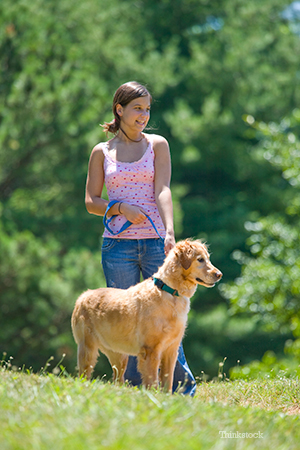Dr. Justine Lee has some tips to help you pooch avoid heat stroke. For more from Dr. Lee, find her on Facebook!
 As August approaches, peak summer heat does too. While I still want you and Fido to spend time outside this summer, it’s really important to know how to do so safely.
As August approaches, peak summer heat does too. While I still want you and Fido to spend time outside this summer, it’s really important to know how to do so safely.
Heat stroke, which is defined in veterinary medicine as a body temperature above > 103°F (39°C), is commonly seen in dogs. While it can occur in cats, it’s really rare. The higher the body temperature, the more life-threatening it is to your dog. As core body temperature approaches > 106°F (41°C), the sooner death can occur.
So, how do you prevent it? By recognizing the top 3 causes for it. As an emergency critical care specialist, I see heat stoke due to:
- Locking a dog in a car without adequate ventilation (this doesn’t mean cracking your windows open!).
- Exercising with a dog when there is excessive heat and humidity – especially if your pet has an underlying medical problem predisposing them to heat stroke!
- Leaving your outdoor dog in the sweltering heat without adequate water or shelter/shade.
Locking a dog in a car
While I’ll occasionally leave my dog in the car for 5 minutes, I lock my doors, turn on the air conditioner on full blast, and turn on my remote starter. Some people say, “Well, maybe your remote starter or car will break.” Possibly, but again, its for super short time periods, and my new Subaru hasn’t let me down yet! Regardless, don’t leave your dog in the car and skip the trip instead. Check out Dr. Ernie Ward’s video on how hot a car truly can get.
Exercising with a dog
Most pet owners are smart enough to know that they shouldn’t be exercising with their pet when 90°F. However, sadly, I’ve seen dogs die at lower temperatures. The most dangerous temperature to exercise in? When it’s a blue, sunny day at 80-85°F. People often feel this is a “safer” temperature, when in actuality, it’s more dangerous. My little tip? If the humidity + temperature added together is greater than 150, it’s too hot.
For example: 80°F + 80% humidity = 160. Too hot to run!
If you want to torture yourself and run outside, go for it, but leave your dog at home!
Medical conditions predisposing your dog to heat stroke
Here are a few medical conditions that can put your dog at risk for heat stroke:
- Brachycephalic syndrome (e.g., a smooshed nose, smaller nostrils than normal, etc.). I’ll expand on this in a few weeks, but for you owners of Pugs, English bulldogs, Shih-Tzu’s, bullmastiffs, Pekingese dogs, etc., this means you! Basically, if your dog snores at night when he sleeps, he’s likely to have brachycephalic syndrome.
- Laryngeal paralysis (a cartilage problem that makes your dog breathe louder than normal at rest)
- Obesity (while we want you to exercise with your dog to help him lose weight, do so during cooler parts of the day like mornings or evenings)
- Heart or lung disease
Do you have any tips? Ever had a heat stroke experience with your dog? Tell us about it!
Dr. Justine Lee
If you have any questions or concerns, you should always visit or call your veterinarian – they are your best resource to ensure the health and well-being of your pets.
Keep Your Dog Cool This Summer: Heat Stroke Part II
